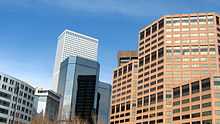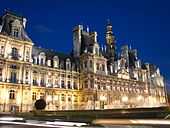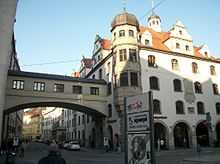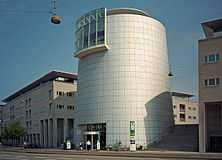Building

A building is a man-made structure with a roof and walls standing more or less permanently in one place. Buildings come in a variety of shapes, sizes and functions, and have been adapted throughout history for a wide number of factors, from building materials available, to weather conditions, to land prices, ground conditions, specific uses and aesthetic reasons. To better understand the term building compare the list of nonbuilding structures.
Buildings serve several needs of society – primarily as shelter from weather, security, living space, privacy, to store belongings, and to comfortably live and work. A building as a shelter represents a physical division of the human habitat (a place of comfort and safety) and the outside (a place that at times may be harsh and harmful).
Ever since the first cave paintings, buildings have also become objects or canvasess of artistic expression. In recent years, interest in sustainable planning and building practices has also become an intentional part of the design process of many new buildings.
Definitions
The word building is both a noun and a verb: the structure itself and the act of making it. As a noun, a building is 'a structure that has a roof and walls and stands more or less permanently in one place';[1] "there was a three-storey building on the corner"; "it was an imposing edifice". In the broadest interpretation a fence or wall is a building[2] However, the word structure is used more broadly than building including natural and man-made formations[3] and does not necessarily have walls. Structure is more likely to be used for a fence. Sturgis' Dictionary included that "[building] differs from Architecture [sic] in excluding all idea of artistic treatment; and it differs from Construction [sic] in the idea of excluding scientific or highly skilful [sic] treatment."[4] As a verb, building is the act of construction.
Structural height in technical usage is the height to the highest architectural detail on building from street-level. Depending on how they are classified, spires and masts may or may not be included in this height. Spires and masts used as antennas are not generally included. The definition of a low-rise vs. a high-rise building is a matter of debate, but generally three storeys or less is considered low-rise.[5]
History
The first shelter on Earth constructed by a relatively close ancestor to humans is believed to be built 500,000 years ago by an early ancestor of humans, Homo erectus.[6]
Types

Residential
Residential buildings are called houses or homes, though buildings containing large numbers of separate dwelling units are often called apartment buildings or apartment blocks to differentiate them from 'individual' houses. Houses may also be built in pairs (semi-detached), in terraces where all but two of the houses have others either side; apartments may be built round courtyards or as rectangular blocks surrounded by a piece of ground of varying sizes. Houses which were built as a single dwelling may later be divided into apartments or bedsitters; they may also be converted to another use e.g. an office or a shop.
Building types may range from one-room wood-framed, masonry, or adobe dwellings to multi-million dollar high-rise buildings able to house thousands of people. Increasing settlement density in buildings (and smaller distances between buildings) is usually a response to high ground prices resulting from many people wanting to live close to work or similar attractors. Other common building materials are brick, concrete or combinations of either of these with stone.
Multi-storey

A Multi-Storey is a building that has multiple floors above ground in the building.
Multi-storey buildings aim to increase the floor area of the building without increasing the area of the land the building is built on, hence saving land and, in most cases, money (depending on material used and land prices in the area). The building with the most storeys is the Burj Khalifa, with 162.
Creation
The practice of designing, constructing, and operating buildings is most usually a collective effort of different groups of professionals and trades. Depending on the size, complexity, and purpose of a particular building project, the project team may include:
- A real estate developer who secures funding for the project;
- One or more financial institutions or other investors that provide the funding
- Local planning and code authorities
- A Surveyor who performs an ALTA/ACSM and construction surveys throughout the project;
- Construction managers who coordinate the effort of different groups of project participants;
- Licensed architects and engineers who provide building design and prepare construction documents;
- Landscape architects;
- Interior designers;
- Other consultants;
- Contractors who provide construction services and install building systems such as climate control, electrical, plumbing, Decoration, fire protection, security and telecommunications;
- Marketing or leasing agents;
- Facility managers who are responsible for operating the building.
Regardless of their size or intended use, all buildings in the US must comply with zoning ordinances, building codes and other regulations such as fire codes, life safety codes and related standards.
Vehicles—such as trailers, caravans, ships and passenger aircraft—are treated as "buildings" for life safety purposes.
Ownership and funding
- Mortgage loan
- Real estate developer
Building services
Physical plant

Any building requires a certain amount of internal infrastructure to function, which includes such elements like heating / cooling, power and telecommunications, water and wastewater etc. Especially in commercial buildings (such as offices or factories), these can be extremely intricate systems taking up large amounts of space (sometimes located in separate areas or double floors / false ceilings) and constitute a big part of the regular maintenance required.
Conveying systems
Systems for transport of people within buildings:
Systems for transport of people between interconnected buildings:
Building damage
Buildings may be damaged during the construction of the building or during maintenance. There are several other reasons behind building damage like accidents[7] such as storms, explosions and subsidence caused by mining or poor foundations. Buildings also may suffer from fire damage and flooding in special circumstances. They may also become dilapidated through lack of proper maintenance or alteration work improperly carried out.
See also
- Autonomous building
- Building material
- Commercial modular construction
- Earthquake engineering
- Famous buildings
- Float glass
- Green building
- Hurricane-proof building
- List of building types
- List of largest buildings in the world
- List of tallest buildings in the world
- Natural building
- Natural disaster and earthquake
- Nonbuilding structure
- Skyscrapers
- Steel building
- Tent
References
| Wikimedia Commons has media related to Buildings. |
| Look up building in Wiktionary, the free dictionary. |
| Wikisource has the text of the 1911 Encyclopædia Britannica article Building. |
- ↑ Max J. Egenhofer and David Michael Mark (2002), Geographic information science: second international conference, GIScience 2002, Boulder, CO, USA, September 25-28, 2002 : proceedings, Springer, p. 110
- ↑ Building def. 2. Whitney, William Dwight, and Benjamin E. Smith. The Century dictionary and cyclopedia. vol. 1. New York: Century Co., 1901. 712. Print.
- ↑ Structure. def. 2. Merriam-Webster's dictionary of synonyms: a dictionary of discriminated synonyms with antonyms and analogous and contrasted words.. Springfield, Mass: Merriam-Webster, 1984. 787. Print.
- ↑ Building. def 1. Sturgis, Russell. A dictionary of architecture and building: biographical, historical, and descriptive. vol. 1. New York: The Macmillan Co. ;, 1901. 2236. Print.
- ↑ Paul Francis Wendt and Alan Robert Cerf (1979), Real estate investment analysis and taxation, McGraw-Hill, p. 210
- ↑ "World's oldest building discovered". BBC News. 2000-03-01. Retrieved 2010-01-02.
- ↑ Building Damage
| |||||||||||||||||||||||
| |||||||||||||||||||||||





.jpg)
